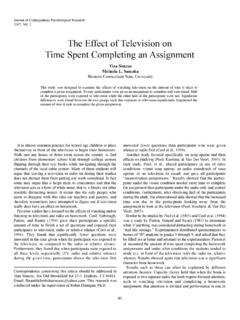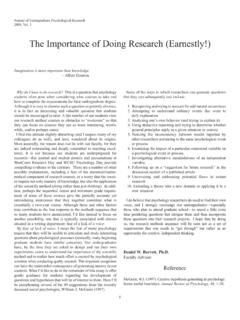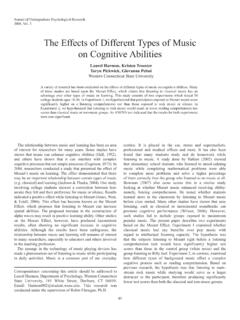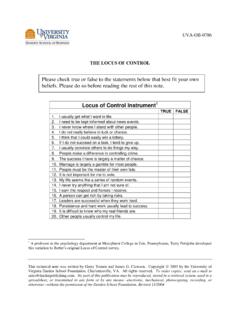Transcription of Does Rap or Rock Music Provoke Violent Behavior?
1 Many researchers have examined the effects of how Music pro-vokes Violent behavior. This is an important issue because of howmuch time people spend listening to studies can helpuncover whether or not Violent and aggressive Music lyrics do infact Provoke individuals to lash out in a Violent et al. (2003) studied whether or not media violenceinfluences youth. They randomly assigned youths to watch eithera short Violent or a short nonviolent Music video and thenobserved how they interacted with other people after viewing themusic video. After each participant watched the Music video forapproximately 15 minutes, both physical and verbal aggressiontowards others was assessed using a 10-point scale: with 1 show-ing nonviolent behaviors and 10 showing a lot of Violent behav-iors. A correlational analysis was used to see if there was a rela-tionship between a participant watching the Violent Music videoand acting Violent , or watching the nonviolent Music video andnot acting Violent .
2 The results showed that exposure to media vio-lence had a statistically significant association with aggressionand violence among youth. This research clearly demonstratesthat exposure to media violence heightens the chances that ayouth will behave aggressively and have aggressive thoughts inthe short run. Arlin (1996) examined the influence of exposure to violentrock videos on participants appraisals of their own aggressive-ness . Participants were preselected based on their scores on ameasure of locus of control . After completing a measure of Bussand Durkee s Hostility Inventory, they were randomly assigned toview either a Violent Music video or a nonviolent Music viewing the Music video, participants once again complet-ed the Hostility Inventory. The results revealed a main effect oflocus of control , such that individuals with an external locus ofcontrol showed lower self-reported aggressiveness after viewinga Music video than individuals with an internal locus of , Jackson and Gatto (1995) studied whether exposure torap Music could cause Violent attitudes and delayed academicperformance.
3 Forty-six African-American males (ages 11 to 16years) from an inner city boys club in Wilmington, NorthCarolina were recruited to participate in this study. Participantswere randomly exposed to Violent rap Music videos, nonviolentrap Music videos, or no Music videos. They read two vignettesinvolving: (a) a Violent act perpetrated against a man and awoman and (b) a young man who chose to engage in academicpursuits to achieve success, whereas his friend, who was unem-ployed, mysteriously obtained extravagant items ( , a nicecar, nice clothes). The results showed that participants who sawthe Violent rap videos reported greater acceptance of the use ofviolence. In addition, participants who saw the Violent rap videosreported higher probability of committing similar acts of violenceand greater acceptance of the use of violence against women. St. Lawrence and Joyner (1991) examined the effects of sexu-ally Violent rock Music on males acceptance or violence againstwomen.
4 The experimental manipulation involved exposure tosexually Violent heavy-metal rock Music , Christian heavy-metalrock Music , or easy listening classical Music . One month prior tothe experimental manipulation, participants were administeredseveral attitudinal scales about religious orientation, sex roles,rape myths, and interpersonal violence. The results indicated thatJournal of Undergraduate Psychological Research2006, Vol. 1 Does Rap or Rock Music Provoke Violent Behavior? Eliana TropeanoWestern Connecticut State UniversityThis study examined whether or not watching a Violent Music video would Provoke individuals to answer ques-tions with Violent responses. Eleven participants watched a Violent Music video, 11 participants watched a non- Violent Music video, and 11 participants were in the control group and did not watch any videos. It was foundthat watching the Violent Music video containing Violent lyrics, aggressive behavior, and degrading behaviorstoward women did make an individual feel and react more violently with regards to responses to questions aboutfictitious scenarios.
5 The conclusion was that watching Violent Music videos does negatively affect behavior. 31 Correspondence concerning this article should be addressed toEliana Tropeano, 17 Pilgrim Hill Rd., Ridgefield, CT : This research was conducted under thesupervision of Patricia O Neill, 32 Music AND VIOLENCE males without a religious background were more accepting ofsexist and rape-supportive beliefs. The researchers also cameacross an unexpected finding which was greater self-reportedsexual arousal in response to classical Music . Kalof (1999) examined the effects of gender and Music videoimagery on sexual attitudes. A group of 44 college studentswere randomly assigned to 1 of 2 groups that viewed either avideo portraying stereotyped sexual imagery or a video thatexcluded all sexual images. A two-way ANOVA revealed thatexposure to traditional sexual imagery had a significant maineffect on attitudes about adversarial sexual relationships.
6 Thereseems to be some confirmation of a relation between sex andexposure to conventional sexual imagery on the acceptance ofinterpersonal violence. Barongan and Nagayama Hall (1995) examined the effects ofcognitive distortions men had towards women. The men in thisstudy viewed women in a sexually aggressive way. The men sbehavior was observed in a laboratory setting. Twenty-seven menlistened to misogynous rap Music and 27 men listened to neutralrap Music . Participants then viewed neutral, sexually- Violent , andassaultive film vignettes and chose the vignette that they foundappealing. The results showed that participants who viewed thesexual- Violent stimuli indeed felt sexually Violent towardswomen, even having thoughts of raping and abusing women (Barongan & Nagayama Hall, 1995, p. 200). Viemer and Paajanen (1992) examined whether or not view-ing Violent television actually does increase the aggressive behav-ior of those who view it.
7 There were 391 eight-year old and ten-year old children participating in this study. These children weretested on their aggression, their fear fantasies, and their dreamand fantasies about these shows. Two measurements of aggres-sion were made: peer-nominated aggression and self-relatedaggression. TV viewing habits were measured by the amount ofTVviewed during the week. Violence was depicted by how reg-ularly Violent TV shows were watched. They found that there wassignificant positive correlation for the boys between TV viewingvariables and aggression. There was also a significant positivecorrelation between the amount of TV and televised violenceviewing and fear and aggressive fantasies about actual shows thatwere seen by the children. These children seem to have beenstrongly impacted by the violence seen on the television showsthey were watching, and then acting in a more aggressive wayafter watching the violence.
8 Mahiri and Conner (2003) have examined whether or not it istrue that our black youth is more Violent than other nationalitiesand why. Is it the rap Music that they may listen to? Theresearchers assessed the perspective on violence of 41 middle-school students attending a unique school in a low-income sec-tion of a large northern California city. The researchers probedways that these students interpreted or reflected upon rap musicand hip-hop culture, particularly its representation of violence,crime, and sex. A brief questionnaire was handed out to each ofthese participants, which consisted of scenario questions (whatwould you do ). Based on the responses to the questionsresearchers were able to come to the conclusion that these partic-ular students were unfortunately looking up to these negative rolemodels. The constant talk of female assault, sex, and violencewas being imbedded into these children s minds.
9 It seems very obvious that there is a significant relationshipbetween listening to Violent Music and watching aggressive andviolent Music videos and one getting into more fights, using inap-propriate language, inappropriate gestures, and a tendency tothink less of women. All of the researchers identified in this paperstudied this exact relationship and found significant results. It isapparent that there is a direct correlation between Violent musicvideos and people behaving violently. An operational definitionof Violent behavior is physically and verbally hurting others,cursing, stealing, inappropriate gestures and negative views ofwomen. Whether it is the lyrics, the beat, or watching the enter-tainers act violently, people in general who are viewing thesemusic videos are behaving in an inappropriate way. The hypoth-esis in this experiment was that there would be a positive relation-ship between the Music one listens to ( Violent and aggressivemusic) and how aggressive one behaves.
10 MethodParticipantsThe participants in this study were 33 undergraduate studentsfrom a northeastern public university. These subjects were at least18 years old. For participating in this study, the participants werecompensated with partial course credit. MaterialsThe materials that were used for this study included an informedconsent, a 12-item questionnaire containing scenario questionsand Music questions directly related to the Music videos shown(See Appendix for questionnaire), two different Music videos(DMX and Will Smith) and a form to fill out so the participantscould receive credit for participating in this study. ProcedureThe time, place and location of this study were posted in a com-mon area. Students met in the experimental room and were givenan informed consent to fill out. The dependent variable was vio-lent behavior. Eleven subjects viewed rap artist DMX andanswered the 12-item questionnaire.




